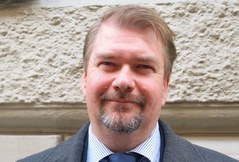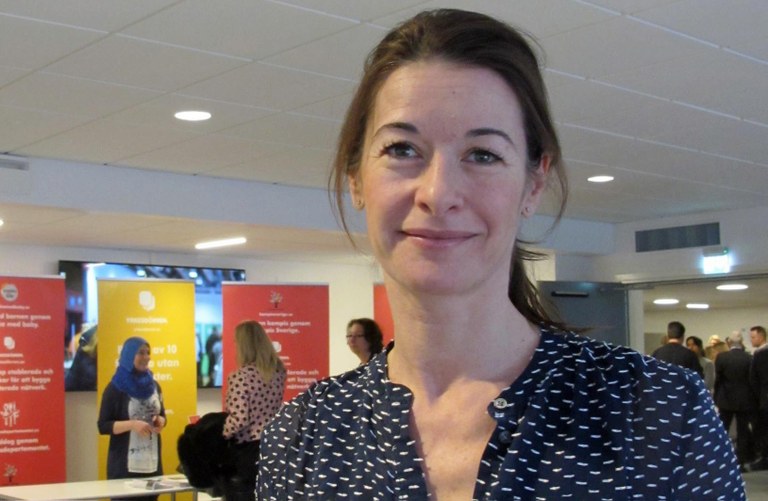Refugees can become an engine of growth
Many types of voluntary organisations played an important role when Sweden received a record number of refugees last autumn. There are many challenges, but with successful integration many municipalities consider refugees to be the solution to the future need of labour.
“We would not have been able to manage the situation last autumn without the voluntary organisations,” said the governor of Stockholm, Chris Heister, as she introduces the sixth regional “Sweden Together” conference.
Her bottom line, supported by the conference in general, is that the large number of asylum seekers coming to Sweden is a positive thing. The refugees will be needed, not least for demographical reasons.
“We need them and they need us,” says Chris Heister.
Cultural walks and football tournaments
It is Gotland’s turn, and the island is explaining how they have been working with the newly arrived refugees. Over a few months last year 900 refugees and 300 unaccompanied children arrived on the island, population 58,000.
“We received as many people in one month as we usually receive in one year,” says governor Peter Molin.
He points out that unlike other municipalities like for instance Malmö, Gotland has enjoyed the advantage of knowing how many would be coming, allowing them to plan accordingly. That does not mean that all of society mustn’t make huge contributions, however - the traditional division into 92 church parishes has played a role, for instance.
“We have a society where cooperation between the municipality, businesses and voluntary organisations is close. There is also strong involvement built on the old parish structures - you come together in your home village to help,” says Peter Molin.
There are many stories about barbecues on some of Gotland’s many beautiful beaches, coffee gatherings where locals and refugees can meet, football shoe collections, football tournaments, cultural walks in the world heritage town of Visby and much more. The general attitude to refugees in Gotland is positive. Gotland wants to grow and aims to increase its population from 58,000 to 65,000.
“Integration is a growth issue,” says governor Peter Molin.
17 regions exchanging experiences
Prime Minister Stefan Löfven was behind the Sweden Together initiative, and the launch was held in Stockholm on 12 October. The aim of the conferences, which are organised by the respective counties’ administrative boards, is to highlight challenges, but also to share positive and negative experiences. The conferences are also attended by state authorities which in different ways are responsible for offering advice and support to municipalities and county councils.
Erik Nilsson, State Secretary at the Swedish Ministry of Labour, told the Gotland conference that the situation from last September to December was exceptional and a great strain on many municipalities. Not least did social services in some municipalities have to work exceptionally hard in order to take care of the many unaccompanied children, who are in need of a completely different level of support than adults. Since 70,000 of the new arrivals are under 18, municipalities are also facing major challenges when it comes to schooling, in the face of a lack of teachers and interpreters.
“At the same time it is important to remember that today’s Sweden is a result of centuries of migration,” he says, and talks about how the city of Stockholm in the 1400s introduced a quota system in the city council to avoid German traders gaining a majority.
A large and important part of the labour market
Today 25 percent of Sweden’s doctors are foreign born, and 800,000 of the total Swedish labour force were born abroad.
 If we didn’t have immigrants the number of people in employment would fall and we would have had an unsustainable dependency ratio because of our ageing population. Many things would not work without the foreign born, who are also enriching our culture,” says Erik Nilsson.
If we didn’t have immigrants the number of people in employment would fall and we would have had an unsustainable dependency ratio because of our ageing population. Many things would not work without the foreign born, who are also enriching our culture,” says Erik Nilsson.
The participating authorities also mirror the areas facing the greatest challenges right now. They are without doubt plentiful. The Swedish Migration Authority is struggling
to find emergency accommodation and to improve the facilities which are not good enough. The authority also wants to speed up the process, to organise support and to help those waiting in today’s large reception system spend their time in a more meaningful way.
They could be taught Swedish, get information about Swedish society, learn how to cater for themselves or they could be offered internships and organised meeting places while waiting for their asylum applications to be processed.
“It is crucial to avoid asylum seekers ending up in a vacuum while they are waiting,” says Erik Nilsson.
Sweden’s National Board of Housing, Building and Planning also says the need for accommodation is acute, and an estimated 700,000 new homes are needed between 2015 and 2025. Where accommodation can be found, for instance in industrial communities, the labour market is often struggling.
The number of refugees received by different municipalities has varied a lot. Shrinking municipalities, for instance Ljusnarsberg and Hultsfred, have received far more refugees per capita than larger cities and university cities. Norberg, an old industrial town in the mining district of Bergslagen, population 5,000, has received 1,000 asylum seekers.
At the same time, the Swedish labour market is strong right now, and there is a rising demand for both skilled and unskilled labour.
“I have been surprised that even sparsely populated areas have had a big need for labour. They often want educated workers like teachers and social workers, and for smaller municipalities it is a challenge to keep hold of those who have an education,” says Erik Nilsson.
Outreach health checks
There has been increased pressure on health care services too. All asylum seekers are to be offered a health check, which has proven hard to do. So far around 40 percent of asylum seekers have been through a health check.
But Erik Nilsson has been listening to good examples and creative solutions during all of the regional conferences, and he has an example for how this can be solved. In Kalmar a doctor packed the necessary equipment in a large, red bag and through his outreach work has managed to provide health checks to 90 percent of all asylum seekers.
At the end of 16 regional conferences, Erik Nilson has a pretty good idea of how regions and municipalities view and are working with the recently arrived asylum seekers. One of his conclusions is that there is more optimism around the reception of asylum seekers across Sweden than what the media implies, and that it has improved since the first conference.
“The media debate is a problem. During the conferences you get a far more nuanced impression. Municipalities describe a situation where there is a lot of hard work, but there is also a will to keep the refugees in the municipality. Many view refugees as an asset and an answer to a growing need for labour, both in the service and care sectors,” says Erik Nilsson.
The exceptional situation means that new solutions keep being found, for instance digital remote native language support when no interpreters can be found, or remote student support. Erik Nilsson has found many good examples during his tour of the country.
The Östersund municipality is for instance working very creatively with accommodation and in Nässjö Swedish is being taught in cooperation with the foundry industry. New partnerships are being born like never before.
“We see types of cooperation between municipalities, businesses and civic society which we have never seen before. Rotary clubs are activating their business networks to look after the newly arrived. Grumpy old men in Hälsingland who have been sceptical to both culture and refugees suddenly find themselves driving newly arrived to cultural events and are happy with that,” he says.
The next step for Sweden Together is to learn more about the regions’ needs and present this to the government and parliament. Erik Nilsson also points to the importance of regional cooperation, the types of which have never been seen before. It is important to make sure such cooperation is long term and sustainable.
“Swedish competitiveness will be strengthened through new languages and different cultures, but first we have to do some hard work,” says Erik Nilsson.

11,000 internships for youths
“If employers are to get involved with helping newly arrived refugees get workplace experience, it is important the CEO says yes and that the HR department develops a plan. It is also smart to work together with the employment service,” says Patricia Kempff, newly appointed head of public affairs at ABB.
After working for six years with labour market initiatives, she knows what she is talking about. Over six years Swedbank created nearly 11,000 internships for youths aged 18 to 24 in its network of companies. 1,500 of them worked for the bank. The experiences gained from that will now be used to match newly arrived Swedes with the needs ABB and other businesses have for new skills. The key is to match the right person to the right internship – that is when people get the contacts and learn the language. For employers it is easier to use internships to invest in people they “might” employ, she says.
“What is cool with Sweden is that we are so closely linked. We carry the Swedish model inside us. But rules and regulations can throw spanners in the wheels,” she says. That is when you need visionary and brave leadership – politically and within business.
- Many initiatives for new Swedes
- A small exhibition outside Sweden Together’s meeting rooms gives a taster of some of the many initiatives which have been launched in order to help newly arrived refugees in Sweden. Here are the Department of Invitations, the Occupation Door, Friend Sweden and Swedish With Baby. Swedish With Baby can be found in several Swedish towns. It is a meeting place for the newly arrived and Swedish families with small children, for their mutual benefit. The network is expanding and today there are 15 groups in Stockholm. “Having the chance to meet Swedish people, find new friends and break the segregation is the most important thing when you arrive in Sweden,” says Nashua Mouaid, the coordinator for Swedish With Baby in the Stockholm area.
 Follow us on Facebook
Follow us on Facebook
